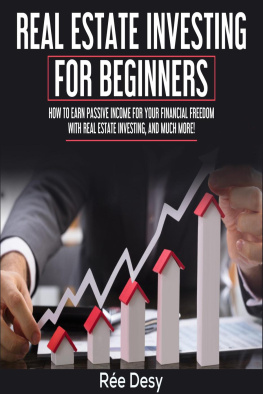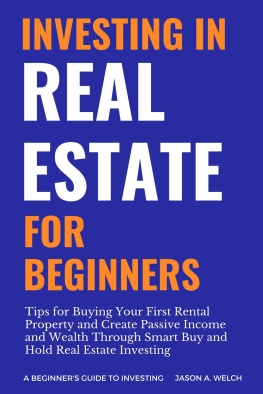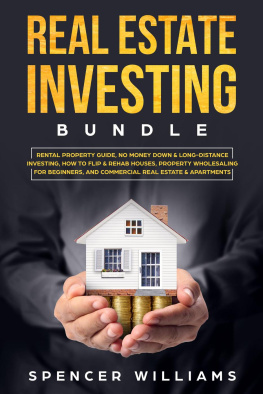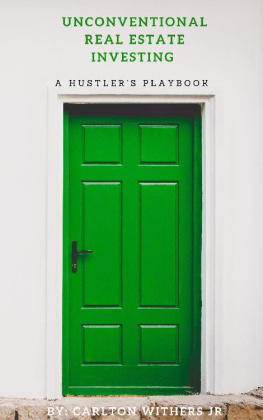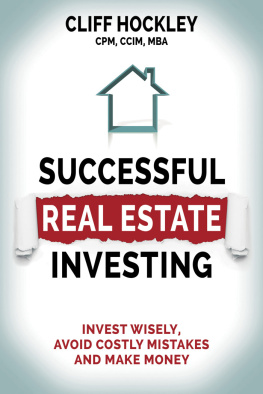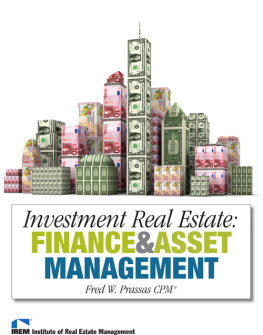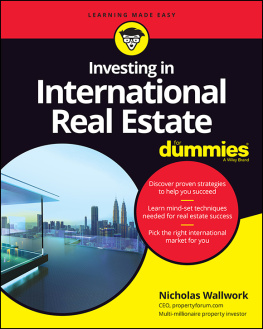Real Estate Due Diligence
The Investors Guide to
Avoiding Costly Mistakes
Joe Torre
Copyright 2021 by JOE TORRE
All rights reserved.
No part of this publication may be reproduced, stored in a retrieval system, or transmitted in any form or by any means, electronic, mechanical, photocopying, recording, scanning, or otherwise, without the prior written permission of the author.
Limit of Liability/Disclaimer of Warranty: While the publisher and author have used their best efforts in preparing this book, they make no representations or warranties with respect to the accuracy or completeness of the contents of this book and specifically disclaim any implied warranties of merchantability or fitness for a particular purpose. No warranty may be created or extended by sales representatives or written sales materials. The advice and strategies contained herein may not be suitable for your situation. You should consult with a professional when appropriate. Neither the publisher nor the author shall be liable for any loss of profit or any other commercial damages, including but not limited to special, incidental, consequential, personal, or other damages.
REAL ESTATE DUE DILIGENCE:
The Investors Guide to Avoiding Costly Mistakes
by Joe Torre
1. BUS054010 2. BUS050020 3. BUS054000
ISBN: 978-1-949642-64-3
EBOOK: 978-1-949642-65-0
Cover design by LEWIS AGRELL
Printed in the United States of America
Authority Publishing
11230 Gold Express Dr. #310-413
Gold River, CA 95670
800-877-1097
www.AuthorityPublishing.com
Smashwords Edition
Dedication
Geraldine Barry
(1964 2019)
To Geraldine Barry,
real estate mentor and friend, who left us too early.
Acknowledgements
Writing a book is a lot more work than I expected and would not have been possible without the support of some seasoned investors and industry veterans who provided great feedback and suggestions that added clarity and completeness to the final version. They include:
Natasha Keck
Kay Gunderson
Elizabeth Macken
Graham Parham
Michelle Pepper
I must also thank my proofreader George Mason () and the team at Authority Publishing for guiding me through the process and protecting me from things I didnt know I didnt know.
Of course, any remaining mistakes or omissions remain mine, alone.
Contents
Part I
Fundamentals of Due Diligence
Part II
Special Situations
Introduction
If you follow the guidelines in this book to the letter, you will never buy an investment property in your lifetime. Thats because no single investment property will check all the boxes and provide the ideal investment that we all want: One that both cash flows and appreciates, one that was purchased below market, has no risk, has tenants who never leave, and makes you money until the end of time.
In the real world, there are tradeoffs. For instance, you may want a brand-new property in a good school district, but that property will likely be too expensive to cash flow. Or you may want a property that offers great cash flow but is in a less-desirable neighborhood with more crime and lower-quality tenants.
You cant have it all, and part of this book is about understanding the tradeoffs and deciding where and how you want to place your bets.
Why I Wrote This Book
I work full-time as an Investment Counselor for a real estate investment firm, and Ive seen a lot of investors make a lot of mistakes over the years, including me. Its easy to make an expensive mistake by missing one small detail, and no investor can be aware of every potential pitfall. Conversely, Ive seen investors who suffer from analysis paralysis: Theyre paranoid about what key factor they might be missing and so they read books and attend seminars for years but never pull the trigger.
Each chapter in this book covers a large enough topic to warrant a book of its own. While I cant include everything there is to know about each topic, I believe provide enough to enable you to make your own investment decisions and ask the right questions of the people you work with.
My goal is to tell it like it isthe way Id want someone to tell me if I were starting out. This book provides the analytical tools for single-family home investors like you, so you can get past analysis paralysis, do proper due diligence, and confidently build a portfolio of investment properties that helps you meet your financial goals.
Focus
There are a lot of investing strategies out there: flipping houses vs. buy-and-hold, new construction vs. existing, and others. For the most part, this book is for buy-and-hold investors, whether buying on your own, through a turnkey provider, or through a new home builder.
How to Read This Book
Throughout the book, youll see little icons or sidebars that add color to the discussion, e.g.:
Exception
The principles outlined in this book are sound but should not be applied robotically. As an investor, you should incorporate general principles but be aware that there may be exceptions to the rule, which if recognized, will enable you to take advantage of opportunities other investors pass up. I will give examples of exceptions to the rule, so you can feel more comfortable bending the rules in real life.
War Story
I will occasionally offer a real-world War Story to illustrate potential pitfalls, based on my experience.
Tip
Periodically Ill insert a Tip that will help you invest smarter or with less risk.
Extra for Experts
Sometimes I will delve into a topic in more detail than is needed by most readers; I will identify these tangents with an Extra for Experts heading. The reader can choose whether to skip over these sections or not.
Dogma Alert!
In general, I attempt to stick to the facts and leave my personal opinions and biases out of the discussion, but sometimes I feel the need to add my two cents. When I deviate from strictly factual presentations, I will warn you with this symbol: Dogma Alert! Youll then know that what follows is my personal opinion only, and not to be taken as gospel truth. Caveat emptor!
Glossary
There are many terms used throughout the book (like turnkey). Their definitions can be found in Appendix A Glossary. I recommend you scan that section before reading the book.
A Word about Pronouns
The English language has no gender-neutral pronoun for a single person, as some other languages do. English requires authors to write he or she or s/he when referring to either or both genders. I find this awkward and unwieldy.
Throughout this book Ill use the pronoun that, in my experience, is the most common for the context. For example, most electrical and plumbing contractors Ive met are men. Actually, all of them were. Most property managers and leasing agents Ive met are women. So when discussing these various players in the real estate world, I will be using he or she according to my experience.
Legal Disclaimer
Finally, to appease the attorneys, I must state that the views expressed in this book are those of the author alone, and do not in any way constitute investing advice. I dont know you or your situation, so I cant presume to offer you advice. Everyone has unique circumstances, goals, and risk tolerances, so you should consult your CPA or financial planner to get advice tailored to your unique situation. All investing involves risk and reading a 200-page guide on the subject does not remove your risk.




